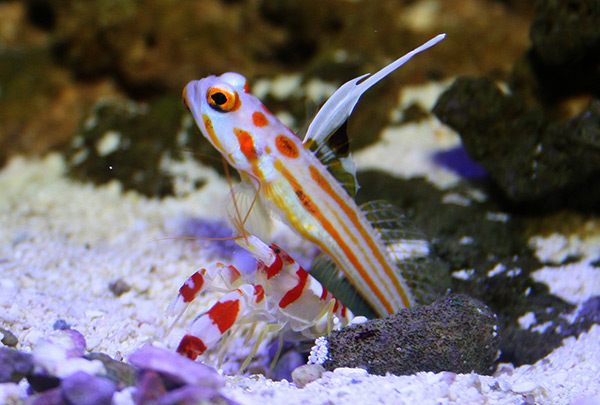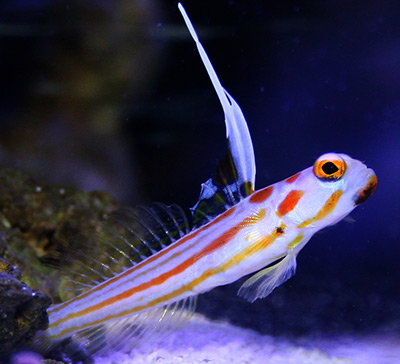Certain marine fish pack a lot of visual and behavioral interest into a very small package. Such is the case with the yasha shrimp goby (Stonogobiops yasha), also sold under the common names whiteray shrimp goby, orange-striped shrimp goby, clown shrimp goby, and others. This little goby, hailing from the western Pacific, is strikingly colored and patterned, very peaceful, and well-suited to smaller systems. Fairly recently identified, S. yasha is also somewhat uncommon in the hobby and (to my pocketbook anyway) a little on the expensive side, but it’s well worth the price if you can source a specimen.
Shrimp symbiont
S. yasha is among the various goby species that have a symbiotic relationship with Alpheus spp. shrimps. In this “Odd Couple” relationship, the two species share a burrow in the substrate with the shrimp continuously excavating and the goby (or goby pair) hovering close by, standing guard against danger. The shrimp, which has very poor eyesight, literally stays in touch with its burrow-mate at all times with its elongated antennae so it can detect immediately via the goby’s body language whether a threat is near and it’s necessary to beat a hasty retreat back into the burrow.
In nature, S. yasha is associated with A. randalli, but it may “partner up” with other Alpheus species in captivity.
Physical traits
S. yasha is white in base coloration with a series of orange-red horizontal, broken stripes running the length of its body. A distinct black patch appears on the chin. Its eyes are orange, high-set and bulbous, and its mouth is comically oversized. In keeping with at least one of its common names, the first ray of this goby’s dorsal fin is highly elongated and white in color. Maximum length is around 2 inches.

Feeding
The yasha shrimp goby is carnivorous and will readily accept small meaty food items, such as mysid shrimp, chopped crustacean/mollusk flesh, and frozen commercial formulations for small carnivores. Multiple daily feedings are recommended.
Housing
As indicated in the title of this post, S. yasha is an excellent choice for nano systems in the vicinity of 20 gallons. Be sure to provide a deep substrate that combines both sand and rubble to facilitate the construction of a stable burrow. Also, cover the tank well, especially when the specimen is newly introduced, to prevent jumping.
Compatibility
S. yasha is a passive fish that should be housed only with equally peaceful piscine tankmates if any are included. Conspecific pairs can be kept together, and, of course, individuals or pairs can be housed with their shrimp symbionts. In fact, a dedicated tank spotlighting the relationship between this goby and an Alpheus sp. shrimp makes for a fascinating display.
As far as reef-friendliness is concerned, S. yasha is exemplary, being completely inoffensive to sessile invertebrates and a threat only to minute motile invertebrates.



